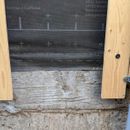Sealant for air barrier
Hi,
I am looking for a sealant for the WRB which is also my air barrier, but I am hoping for something that is sold in the large box stores (DAP, LePage, Mono…) due to the higher cost and shipping cost of Siga, Pro Clima…
I want to mention that the WRB needs to seal against concrete which is very rough and uneven in a number of locations as shown in the below pictures.
I also plant on using the same sealant for the vapor barrier to my sill plate inside the house
Thank you,
Arnold
GBA Detail Library
A collection of one thousand construction details organized by climate and house part











Replies
Acoustical sealant would serve the purpose, but it is ugly, messy stuff. But it works.
Is there a specific brand of acoustical sealant that works better for exterior use on concrete?
Thanks,
Arnold
arnoldk,
GBA has hosted a series of tape tests going back to (I think) 2013. Here is one of the latest ones you may find useful: https://www.greenbuildingadvisor.com/article/testing-construction-tapes-part-1
Hi Malcolm,
I am looking for some type of sealant (Polyurethane/Butyl) since tapes tend to be expensive and on rough/uneven surface, a primer is recommended which adds to the cost.
Thanks,
Arnold
I have had very good luck using polyurethane caulks from Loctite's PL line for stuff like this. Put down a medium-size bead of PL sealant, then roll over the top of the second thing being sealed to press things together and flatten out the bead of sealant. Polyurethane is a LOT more durable than silicone for stuff like this. The only tricky part for you from what I see in those pics is that you need overlapping materials to be able to seal with caulk. If you just have sort of butt joint, you really need to use a tape.
Bill
Thanks Bill.
I need to seal the house wrap (black) to the concrete foundation wall. Would the LePage PL Acousti-Seal Sound Absorbing Vapor Barrier Adhesive work well?
Thank you,
Arnold
It probably would. If you have any doubts, buy a tube and test it on a sample of the materials you want to bond. Make sure that it will cure to a solid material, which it looks like it will, and it should since it's listed as an 'adhesive'.
It looks like this product isn't "acoustical sealant", which is good for your application. Regular acoustical sealant/caulk is intended to stay gooey forever, so it never cures to a solid the way normal caulk does. The side effect of that is that it stays gooey, sticky, and messy forever, and it can't be used to glue things. Acoustical sealant is used in places where you expect the parts might move over time, so you want the sealant to stay gooey so that it won't break the seal. Parts in this kind of application have to be fastened by other means (like drywall is fastened to the framing with drywall screws), so it's for a very different application from what you are trying to do.
Bill